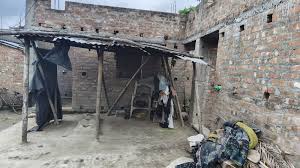‘Entire village ganged up to finish a family’: Police arrest three of 23 named in FIR for Bihar ‘witchcraft’ murders

In a harrowing incident that has shaken the conscience of the nation, five members of a tribal family were brutally murdered in Bihar’s Purnia district, accused of practicing witchcraft. The victims, belonging to the Oraon tribe, were beaten, burned, and their bodies discarded—allegedly by their own neighbors. This horrific act underscores the persistent grip of superstition and social ostracism in rural India.
What Happened in Tetgama?
The massacre unfolded in the remote village of Tetgama under the Mufassil police station jurisdiction on the night of July 6, 2025. The victims included 65-year-old Babulal Oraon, his 82-year-old mother Kato Devi, wife Sita Devi (60), son Manjeet (25), and daughter-in-law Rani (22). All were accused by local villagers of causing deaths and illnesses in the area through “black magic.”
Witnesses say that a large group of villagers—possibly numbering over a hundred—stormed the family’s home. They dragged the family members out, beat them mercilessly with sticks and rods, and later set their bodies on fire. Some of the bodies were thrown into a nearby pond using a tractor.
Police Confirm Mob Conspiracy
Following the incident, Purnia police registered a First Information Report (FIR) against 23 named individuals and up to 200 unknown assailants. So far, three suspects, including a teenager, have been arrested. According to senior officials, this was not a spontaneous act but a coordinated attack, possibly with the silent approval—or fear-induced compliance—of the entire village.
Police investigation revealed chilling details: victims were first beaten to death, then their bodies were set ablaze, and efforts were made to erase evidence. A search operation is underway to find the remaining accused. Forensic teams and dog squads have been deployed.
Why Witchcraft?
The belief that misfortunes like illness or death are caused by witchcraft persists in many parts of rural India, especially in tribal-dominated areas like Bihar, Jharkhand, Odisha, and Chhattisgarh. Often, vulnerable people—mostly women, the elderly, or marginalized groups—are branded as witches and subjected to inhuman treatment.
In Tetgama, the trigger appears to be the deaths of a few local children and some unexplained illnesses. Instead of seeking medical help, the villagers turned to ancient superstitions. Rumors spread quickly, and the Oraon family became the scapegoat.
Political and Public Outcry
The massacre has drawn widespread condemnation. Bihar’s Director General of Police (DGP) Vinay Kumar stated that superstition played a key role, adding that forensic reports confirmed the victims were already dead when they were burned. He promised strict action and speedy arrests.
Jharkhand Chief Minister Hemant Soren demanded accountability from Bihar’s administration, calling the atrocity a “grim reminder of growing lawlessness and violence against tribals and Dalits.”
Meanwhile, the Jharkhand Congress sent a fact-finding team to Purnia, noting that such violence must not go unpunished or ignored. Human rights activists have also called for education and awareness programs to combat the deep-rooted belief in witchcraft and occult practices.
Historical Context: A Widespread Issue
Unfortunately, this is not an isolated incident. According to India’s National Crime Records Bureau (NCRB), over 1,500 people were killed in witchcraft-related violence from 2010 to 2021. Most of these crimes occurred in rural areas with poor access to healthcare and education.
States like Jharkhand, Chhattisgarh, and Odisha have passed specific laws to prevent witch-hunting. Bihar also has laws in place, but enforcement remains a challenge. In many cases, local police either delay action or fail to provide protection to victims after receiving complaints.
Underlying Motives: More Than Just Superstition
While superstition is the most visible reason for such crimes, experts argue that land disputes, family feuds, or attempts to silence dissenting voices often lie underneath. Branding someone a “witch” or “sorcerer” becomes an easy excuse to eliminate them without direct confrontation.
In the Purnia case, police are also exploring whether there were land ownership disputes or social tensions involving the Oraon family.
Village in Shock, Authorities on Alert
Since the killings, the entire Tetgama village has fallen silent. Many residents have fled, fearing police action or public backlash. Security has been tightened, and investigators are piecing together the timeline of the crime.
Psychological counseling and legal aid have been offered to surviving members of the family, though none remain in the village. NGOs are urging the Bihar government to ensure long-term rehabilitation for survivors and initiate village-level campaigns against superstition.
What Needs to Change?
This massacre is yet another grim reminder that legal frameworks alone are not enough. There is a need for:
- Mass education campaigns in vulnerable regions.
- Healthcare access, especially mental health and child health support.
- Community awareness to break the cycle of blame, fear, and rumor.
- Training local police to recognize witch-hunting signs early and intervene.
- Monitoring local influencers, like traditional healers or quacks, who often spread such beliefs.
Final Thoughts
The lynching of the Oraon family in Bihar is more than a crime—it is a cultural and social failure. It reflects how superstition, unchecked rumor, and community silence can escalate into collective violence. Until India addresses these deep-seated issues through education, empathy, and strong governance, such tragedies will keep repeating.
No one should die for the superstitions of others. The victims of Tetgama deserve justice—not just in court, but through a transformed society.






